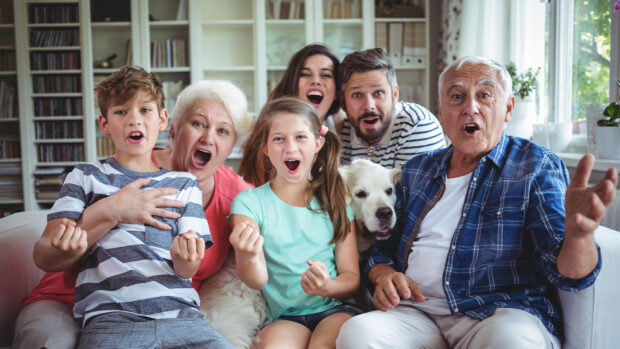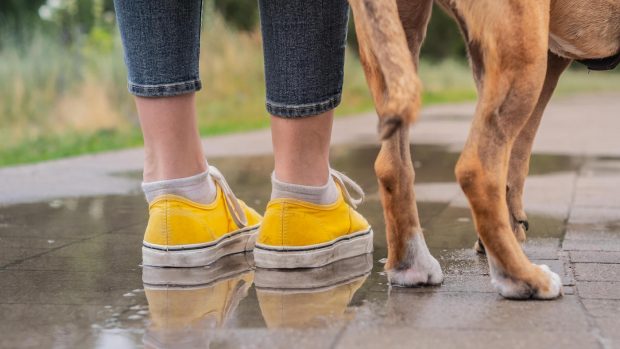When we think of how to train a dog, most people will automatically think about obedience, teaching dogs how to lie down, sit, stand and wait, puppy classes and recall – all of which do help. In fact, they are the extras you want from your dog and first you need to establish the foundations.
If you ask the majority of dog owners what they want from their dog, most will answer that they want a dog that is well behaved and polite – when they are out, at home, and in front of people – that they come back when called and they do not jump up.
The key to achieving a balanced and well-mannered dog starts the minute that you bring them home from either a breeder or a rescue facility. A rescue dog can, of course, be a little more complex with underlying learnt behaviours, but that is not to say that they cannot begin to adapt slowly once home with you. You need to consider behavioural expectations, consistency, boundaries, positive rewards, socialisation, impulse control, routine, introduction to the lead and loose lead walking, puppy fear stages and their impacts, environmental control, habituation and nurture. And we’ve not even got to what most people perceive as obedience.
These are basic principles that you need to have established before you even think about dog classes and obedience. If these are not in place and done religiously day in day out – similar to brushing your teeth every morning, or saying please and thank you without even thinking – then you will make your life a lot more difficult than it needs to be. Through no fault of their own, you will also have a confused and problematic dog.
How to train a dog: the foundations
Behavioural expectations
These are vast and encompass toilet training, food manners, rest and bedtime, general manners, lead walking, recall, going in and out of doors and cars, greeting people and mouthing to name a few. So, what are they? Put simply, a dog can only do what you ask it to do and what you teach it, the same with children and adults. It’s no good just expecting a dog to know not to jump up or know how to walk without pulling on the lead – they must be taught and given a command, or they’ll make the “dog decision”, not out of malice but out of lack of guidance from you.
Wherever I go with my dogs, I tell them every step of the way what I want. When I’m passing people, I give the “leave it and with me” command. When I’m meeting dogs and people it’s “off and gently”. Then I give a “yes” command every time they follow instruction and sometimes a treat, which is positive reinforcement. They know how to behave now, but I still tell them regardless. If I don’t, it’s likely they will do the wrong thing or make the wrong decision because they are too curious and I’ve not set an expectation. This leads nicely onto consistency.
Consistency
Once you understand your dog’s personality, whether they’re happier being crated or left with in a pen to help toilet training and sleeping at night, when is the best time to feed and walk them, consistency is key. Often problems occur when not everyone in the household is singing from the same hymn sheet.
If you’ve meticulously and positively prevented your dog from jumping up at you, but then your partner comes home and allows the dog to jump all over them, then fusses them. The frustration from you and the wrong response from others leave you with a confused dog who doesn’t know what is right and what is wrong – all because there is no consistency. It’s the same when you teach them to walk nicely, to recall or wait for their food. If this is not done the same way every day by everyone, then how can you expect the dog to understand and do the right thing?
Routine
Everyone likes routine and a lack of it is certainly unhealthy for dogs, too. Routine is key to their mental wellbeing, security, and safety. Life throws curveballs, of course, and things happen that can knock you off your daily routine but if you usually let your dog out first thing, particularly a puppy you’re house training and decide that you’ll wait until it stops raining, do not be surprised to come back to a puddle and a poo.
Dogs like their morning routines and their evening routines, and this usually coincides with feeding, too. My mum’s German Shepherd is a classic example of a dog that needs routine. He is awesome in every aspect, but if you allow him to sleep somewhere other than he usually does, over the next few days he becomes rude and stops listening. He can soon be reined back in again, but the point is that dogs can make decisions that are not necessarily healthy or right. All we have to say to Ranger is, “Right its sleep time” and he goes straight in his crate with his lick pad and you won’t hear a peep until morning. We then have a relaxed contented and listening dog. Routines that co-exist with positive things in a dog’s life, such as treats, rewards and food, make it all the easier.
Positive reinforcement
Positive reinforcement can be anything from the “yes” command and a stroke, to throwing a toy or giving a high-value reward, such as sausages or cheese. It is important to affirm the behaviour that you want, whether that is settling nicely or not jumping up or sitting quietly rather than barking excessively.
It’s important to correct and redirect, showing right from wrong, but too often I see behaviours diverted with treats rather than corrected. This may suppress the barking or the jumping up but once the dog has had the food or toy reward, the behaviour will start again as there has been no consequence for their actions. This means they repeat the behaviour and they’ll soon learn how to manipulate the situation to gain the reward.
Once you manage to stop the unwanted behaviour and then follow it with a reward, the association is much more likely to stick. This is proactive rather than reactive teaching, stopping the behaviour before it starts.
Environmental control
This is essential with a nervous, fearful, reactive or even an over-exuberant dog. There is no such thing as pack leader or dominance in the canine world – we should not be “dominating” and bossing dogs. It is up to you to be the safe person, the person your dog can rely on to make the decisions to keep him safe and remove the worry and the fear.
If a dog is over-excited, they need you to take the energy out of a situation and remain calm before they can continue on with what you were doing. If you don’t, the dog remains in a hyper-aroused and over-stimulated state, unable to listen, comprehend and have a thought process. He won’t be able to contain his emotions because you’ve not helped him, taught him or focused him in a way he can understand. You need to make the decisions – and by doing that you will have a trusting dog with a strong bond that relies on you for their safety and emotional wellbeing, but you’ll also be their soother and focus before his impulses get the better of him.
Socialisation
Taking your dog everywhere and doing everything with them every day can be too much. There is a fine line between too much socialisation and too little. Too much socialisation can make your dog reactive or fearful if they’re of the shyer disposition because doing something more will not change their personality. You cannot turn an introvert into an extrovert, so the more you put a shy dog into that position the more negative it becomes. The dog then begins to dread the daily onslaught of more dogs and people until his only way of communicating is to be fearful, hide, bark or be reactive as a way of coping with the negative emotions he’s feeling.
Society is guilty of asking for too much from dogs and expecting them to deliver no matter the cost to their happiness. I do not want everyone I meet to stroke or cuddle me and I certainly do not want to socialise with every person that I meet either. It’s the same for dogs. Likewise for the over-excited, over-friendly dogs, the more you allow them to try to greet everyone and everything they see, the less impulse control they have. This increases the risk of them being attacked by a dog that’s not happy to be jumped all over and barked at.
Little and often is the key and practising when your dog can and cannot interact. Be your dog’s voice if it’s shy and does not want to be stroked – do not allow people to just force themselves upon your dog. It’s the reverse for the over-excitable dogs – not everyone likes dogs and not everyone wants one that is hyper, jumps up at them, covering them in mud or scratching them. Do not allow your dog to drag you to every single person or dog that it sees and create a scene.
Habituation is a natural learning process where a dog becomes desensitised to repeated or consistent stimuli. It involves exposing your dog to a range of stimuli, gradually helping them become comfortable and less reactive over time. Habituation plays a significant role in shaping your dog’s responses to new situations, sounds, and environments, this begins the minute you bring them home.
You might also be interested in:

How to master loose lead walking

How to house train a dog: guidance from an expert

How to stop your dog jumping up

How to stop a dog begging for food

Signs, causes and coping strategies for reactivity in dogs – explained by an expert

Subscribe to Horse & Hound magazine today – and enjoy unlimited website access all year round
Horse & Hound magazine, out every Thursday, is packed with all the latest news and reports, as well as interviews, specials, nostalgia, vet and training advice. Find how you can enjoy the magazine delivered to your door every week, plus options to upgrade your subscription to access our online service that brings you breaking news and reports as well as other benefits.




